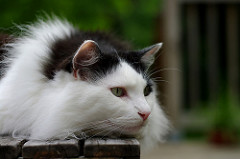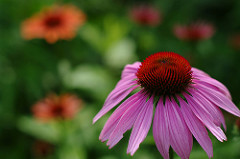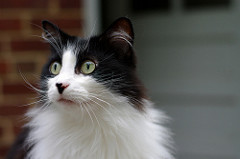I’ve used a Rebel XT for the past 2+ years, and it’s been a great camera for me. I haven’t wanted for megapixels – 8 is plenty for pretty much any print I’ve wanted to make. It shoots fast enough for anything I need to capture. The LCD is tiny by current standards, but I don’t look at it very often – mostly just to check focus and level. It’s worked very well with my collection of M42 screw mount lenses via an inexpensive adapter.
One shortcoming of the Rebel XT is that it only has one adjustment dial that can’t be configured. I mostly shoot with manual lenses in aperture-priority mode, so it would be very nice to be able to configure the dial to adjust ISO. Another odd shortcoming is the lack of focus confirmation for manual lenses. There are manual lens adapters available that have chips to trick the camera into doing focus confirmation, but there’s no reason Canon couldn’t have just enabled it. It also has no sensor self-cleaning function, so I’ve usually got a couple bits of dust on the sensor annoying me.
So, I had a few requirements for a new camera, plus a couple of wishes:
- More megapixels
- Bigger LCD
- Easy/cheap M42 lens adaptation
- Self-cleaning sensor
- Focus confirmation with manual lenses
- At least 2 adjustment dials
- Dust/moisture seals and in-camera image stabilization might be nice…
I wanted to stick with Canon so I considered a Canon 40D, but it wouldn’t have been much of a megapixel improvement over the Rebel XT. The 50D would have, but it was a bit too expensive. So, I looked at other brands. Olympus and Pentax cameras both adapt well to M42 lenses. The reviews for Olympus’ DSLRs are a bit mixed, but the lens mount can be adapted to a wider variety of old lenses. I liked the idea of a Pentax because they make a few interesting modern lenses, such as a nice 50/1.4 and some odd “pancake” lenses. Even though I mostly use manual lenses, it’s nice to have an autofocus lens for some situations. The K20D had all of the features I wanted, decent reviews, and an acceptable price. I got it, plus a 50/1.4 lens, for what a 50D would have cost.
So far I like it. It’s big and heavy compared to the Rebel XT, but I guess that makes it feel more solid and professional. There are plenty of controls and they’re placed pretty well.
The M42 adapter I got has been a little disappointing. It got stuck on the camera due to an odd spring thing. Without the spring it doesn’t click into place, but at least it can be removed. It seems to work best to attach the adapter tightly to a lens, then just use that lens like a K-mount lens. That would work fine to use a single M42 lens, but I usually want to use several. I could get a few of the cheap adapters and attach them to lenses as needed, but I decided to order an official Pentax adapter to see if that’ll work better.
In the meantime, I’ve mostly been using the FA 50/1.4 lens that I decided to get with the camera. It’s a very nice lens, as good as my 50/1.4 SMC Takumar (but with autofocus for easier cat photography). Here are a couple of the photos I’ve taken with the K20D and FA 50/1.4 so far:






